1. Introduction
The plant species most frequently referred to in English as rice is Oryza sativa L., also referred to as Asian rice. Given that it is both an essential food source and the first crop genome to be fully sequenced, it has a special place among domesticated crop species. The grass genus Oryza of the Poaceae family contains Oryza sativa. It is a model organism for the botany of grains and has a genome that is easy to genetically manipulate with 430 Mbp spread across 12 chromosomes [1].
The total world production of rice, wheat and maize is estimated at 519, 776.7 and 1192 million tonnes in 2021-2022 which is 0.6, 7.2 and 35.76 million tonnes more than that for 2020-21, respectively. An analysis of these figures suggests that rice, wheat and maize account for 18.5, 27.7 and 42.5 per cent of global cereal production—around 89 per cent of the total. China (24 per cent), India (19 per cent), Bangladesh (7 per cent), Indonesia (6 per cent) and Vietnam (5 per cent) top the world in production of Rice [2]. However, Rice, wheat, and maize together directly supply more than 50% of all calories consumed by the entire human population. Moreover, the average person consumes 150 to 200 kg annually, which makes up at least two-thirds of calorie intake and around 60% of daily protein consumption in nations like Bangladesh, Vietnam, and Myanmar [3]. Additionally, rice is the most significant crop for the millions of small farmers that cultivate it across the region on millions of hectares, as well as the numerous landless labourers who earn a living by laboring on these fields. Future rice output must increase at a rate that is at least as fast as population growth, if not faster. To address this requirement and contribute to global initiatives aimed at reducing poverty, rice research and the introduction of new technology for all farmers are crucial.
Rice farming has traditionally been a difficult, labor-intensive endeavor. The greatest input cost for the production of rice is labor [4]. Due to an increase in high-paying non-farm employment opportunities, labor force migration to cities, and the low social status of agricultural laborers in Bangladesh, the country’s agriculture has been confronted with serious labor shortage problems both during peak agricultural season and during other times [5]. The only way to reduce the labor shortage during the peak and regular periods of rice production is through mechanization. Agricultural mechanization using small-scale machinery for agricultural production has been one of the outstanding developments in developed countries [6].
In Bangladesh, rice cultivation is becoming more mechanized, including the seedling raising and transplanting of seedlings [7] [8]. Root-washed seedlings that are 30 to 40 days old are used for manual transplanting, whereas mechanical transplantation uses mat-type seedlings that are 15 to 18 days old during the wet season and 25 to 30 days old during the dry season [9]. Mat-type seedlings are raised either on a plastic tray (280 × 580 × 25 mm) or a polythene sheet with the help of frames. The mat-type seedlings are raised with a 20 - 25 mm thick sieved soil layer mixed with farm yard manure or organic manure placed in trays or over polythene sheets. The mat thickness for best results of seedling raising is about 20 mm [10] [11]. Normally, 120 to 140 gm seeds are used in a tray for high-yielding rice variety in Bangladesh conditions [9]. But there have no enough studies on the hybrid rice variety. Recently, different organizations are trying to use hybrid rice varieties for mechanical transplanting in Bangladesh [12].
Seed rate per tray or if a mat is used, the seed rate is very important as the growth of seedling and also agronomic parameters of transplanting depend on it [13]. If the seed rate is higher than the optimum, the growth of the seedling is obstructed due to nutrient deficiency. Seed rate less than the optimum rate leads to a high missing rate in transplanting as well as weak bonding of the mat [14]. The optimum seed tare per tray is also beneficial for hybrid rice cultivation as the cost of hybrid variety seed is more costly than inbred and local high-yielding varieties. As the technique of hybrid rice variety cultivation varies from inbred varieties, the development of a seedling raising technology with an appropriate seed rate and performance of the existing rice transplanter for hybrid rice is the prerequisite for establishing mechanical transplanting of hybrid rice varieties. Based on discussion, it is hypothesized that seedling quality would be improved with the desired seed rate of different hybrid rice varieties that could relate to the suitable seedling adjustment options of the rice transplanter for maintaining the desired number of seedlings per stroke by the rotary picker of the transplanter. The main objective of this study was to determine the optimum seed rate of hybrid rice (Oryzasativa L.) varieties in mat-type seedling raising for mechanical transplanting in Bangladesh
2. Materials and Methods
The experiment was conducted in the Farm Machinery and Postharvest Technology Division, Bangladesh Rice Research Institute (BRRI), Gazipur during the irrigated dry (Boro) season, 2022. All treatments used the same seedling growth medium. The following inbred and hybrid dhans were employed in the study BRRI dhan89 [15], Ishpahani hybrid dhan6 [16], BRRI hybrid dhan5 [15] and BRRI hybrid dhan3 [15]. To conduct the study, a two-way Completely Randomized Design (CRD) with two factors and three replications was used. Rice varieties as the main factor (4 variety) whereas seed rate (g?tray?1) as sub-factors were 80 (S1), 90 (S2), 100 (S3), 110 (S4) and 120 (S5) g per seedling tray (280 × 580 × 25 mm).
2.1. Seedlings Preparation
A plastic tray (280 × 580 × 25 mm) was used for raising seedlings. Same clod-free growing media was used to fill up the trays to a depth of 20 mm. As per the design, pre-germinated seeds were spread uniformly on each tray. After sowing, fine and loose soil was spread over the seeds to 3 - 5 mm depth. Mat type seedling of the studies varieties were transplanted at 22 days after sowing. Field duration of the Ishpahani hybrid dhan6 was more compare to the BRRI hybrid rice varieties (Table 1).
2.2. Data Collected
Germination percentage, number of seeds per unit area, number of germinated seedlings per unit area, number of seedlings per unit area, and percentage of seeds raised as effective seedlings were calculated. Seedling density and seedling height were measured to measure the seedling quality. A 20 cm2 metal sheet boxes used to determine the seedling density. Digital slide calipers and a scale were used to measure the thickness and height. Hills per unit area, plants per hill, missing hills including buried, damaged, and floating hills at a fixed setting of the rice transplanter (line to line: 30 cm and plant to plant: 14 cm) were measured by setting a box of 1.0 m2 to observe the transplanting performance under different seed rate of mat preparation. Tiller number and plant height were assessed from 12 hills per plot on different days after transplanting. Rice grain yield per plot was recorded from a pre-selected 10 m2 harvest area and was determined with the adjustment to 14% moisture content. Other agronomic and yield parameters were recorded from these quadrats. A number of hills?m?2 was counted from a total number of hills in a 10 m2 pre-selected area.
2.3. Transplanter Setting during Operation
There are three options in the rice transplanter (DP 480) to adjust the hill spacing (plant-to-plant spacing). The transplanter was set to maintain a 150 mm distance between each hill’s spacing in the row. Spacing between rows (line to line spacing) is fixed to 300 mm for the rice transplanter. It was adjusted to the medium depth mode during transplanting to maintain a 20 - 30 mm depth of seedling placement. There have nine options to select several plants?hill?1. The rotary picker of the rice transplanter was set at position 4 to maintain similar numbers of seedlings?hill?1 irrespective of seed rate and variety.
2.4. General Information of the Experiment
![]()
Table 1. General information of the study.
2.5. Physical Parameters of the Varieties
Physical parameters of the four selected varieties as well as germination percentage were measured and presented in Table 2. Germination percentages of the selected varieties were similar while seed thickness of all hybrid varieties was more compared to the BRRI dhan89.
![]()
Table 2. Physical parameters and germination percentage of the varieties.
Note: Variety: V1: BRRI hybrid dhan3, V2: BRRI hybrid dhan5, V3: Ishpahani hybrid dhan6 and V4: BRRI dhan89.
2.6. Statistical Analysis
Data will be analyzed as a two way factorial design (variety × seed rate) according to Gomez and Gomez [17] using Crop Stat 7.2 software [18]. Means will be compared with the least significant difference (LSD) at which level of significant percentage test using Statistix 10 program [19].
3. Results and Discussions
3.1. Seedling Density
Seeds density was measured immediately after sowing while seedling density was measured at 7, 14, and 21 days after sowing (Figures 1-4). Seedling density increased linearly with the increase in seed rate irrespective of the varieties except 21 days after sowing. At 21 days after sowing, the seedling density of all hybrid varieties increased with the seed rate while the seedling density of BRRI dhan89 decreased after the seed rate of 100 g/tray because of mortality. Seedling density on the tray is influenced by the seed rate, germination percentage, and seedling survival rate [9] [20]. For indicia rice, densities of 1.5 to 3 seedlings per 100 mm2
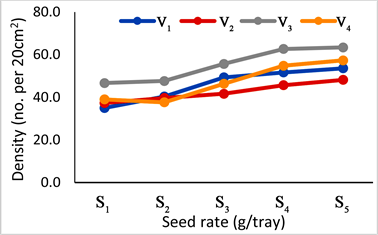 Note: Variety: V1: BRRI hybrid dhan3, V2: BRRI hybrid dhan5, V3: Ishpahani hybrid dhan6 and V4: BRRI dhan89 and Seed rate: S1: 80 g?tray?1, S2: 90 g?tray?1, S3: 100 g?tray?1, S4: 110 g?tray?1 and S5: 120 g?tray?1.
Note: Variety: V1: BRRI hybrid dhan3, V2: BRRI hybrid dhan5, V3: Ishpahani hybrid dhan6 and V4: BRRI dhan89 and Seed rate: S1: 80 g?tray?1, S2: 90 g?tray?1, S3: 100 g?tray?1, S4: 110 g?tray?1 and S5: 120 g?tray?1.
Figure 1. Seed density after immediate after sowing (S: p < 0.01, V: p < 0.01 and S × V: p < 0.01).
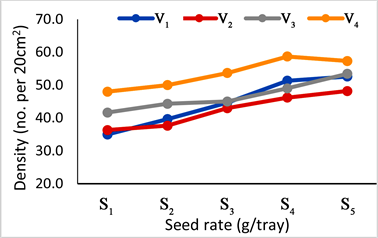 Note: Variety: V1: BRRI hybrid dhan3, V2: BRRI hybrid dhan5, V3: Ishpahani hybrid dhan6 and V4: BRRI dhan89 and Seed rate: S1: 80 g?tray?1, S2: 90 g?tray?1, S3: 100 g?tray?1, S4: 110 g?tray?1 and S5: 120 g?tray?1.
Note: Variety: V1: BRRI hybrid dhan3, V2: BRRI hybrid dhan5, V3: Ishpahani hybrid dhan6 and V4: BRRI dhan89 and Seed rate: S1: 80 g?tray?1, S2: 90 g?tray?1, S3: 100 g?tray?1, S4: 110 g?tray?1 and S5: 120 g?tray?1.
Figure 2. Seedling density after 7 days of sowing (S: p < 0.01, V: p < 0.01 and S × V: p > 0.05).
 Note: Variety: V1: BRRI hybrid dhan3, V2: BRRI hybrid dhan5, V3: Ishpahani hybrid dhan6 and V4: BRRI dhan89 and Seed rate: S1: 80 g?tray?1, S2: 90 g?tray?1, S3: 100 g?tray?1, S4: 110 g?tray?1 and S5: 120 g?tray?1.
Note: Variety: V1: BRRI hybrid dhan3, V2: BRRI hybrid dhan5, V3: Ishpahani hybrid dhan6 and V4: BRRI dhan89 and Seed rate: S1: 80 g?tray?1, S2: 90 g?tray?1, S3: 100 g?tray?1, S4: 110 g?tray?1 and S5: 120 g?tray?1.
Figure 3. Seedling density after 14 days of sowing (S: p < 0.01, V: p < 0.01 and S × V: p > 0.05).
 Note: Variety: V1: BRRI hybrid dhan3, V2: BRRI hybrid dhan5, V3: Ishpahani hybrid dhan6 and V4: BRRI dhan89 and Seed rate: S1: 80 g?tray?1, S2: 90 g?tray?1, S3: 100 g?tray?1, S4: 110 g?tray?1 and S5: 120 g?tray?1.
Note: Variety: V1: BRRI hybrid dhan3, V2: BRRI hybrid dhan5, V3: Ishpahani hybrid dhan6 and V4: BRRI dhan89 and Seed rate: S1: 80 g?tray?1, S2: 90 g?tray?1, S3: 100 g?tray?1, S4: 110 g?tray?1 and S5: 120 g?tray?1.
Figure 4. Seedling density after 21 days of sowing (S: p < 0.01, V: p < 0.05 and S × V: p < 0.05).
are required for minimizing the missing hills and maintaining optimal number of seedlings?hill?1 [21]. For rice inbred variety, 140 g of seeds?tray?1 for short and bold grain, 130 g of seeds tray-1 for medium and slender grain and 120 g of seeds?tray?1 for extra-long and slender grain under the seedling adjustment options of 4 to 7 may be used for desired seedlings per hill and minimum missing hills [9].
3.2. Seedling Height
Seedling height was measured at 7, 14, and 21 days after sowing (Figures 5-7). At 7 days after sowing, seedling height only varied significantly with the varieties while at 7, 14 and 21 days after sowing, it was varied with both variety and seed rate. The seedling height of the BRRI hybrid dhan5 and Ishpahani hybrid dhan6 were significantly more compared to the BRRI hybrid dhan3 and BRRI dhan89 (Figures 5-7). At 21 days after sowing, seedling height gradually decreased with the increase of seed rate. The seedling height for mat-type seedling raising is one of the major criteria in mechanical transplanting and the lowest seedling height increased the buried hill [20]. Different organic soil media influenced the seedling height upto 17.06 mm whereas the optimum seedling height is 120 mm which is coincided with the study [21] [22].
3.3. Number of Hills per Unit Area
The two-way interaction of varieties and seed rate did not show a significant effect on a number of hills/m2 while variety and seed rate individually showed a significant effect on the number of hills/m2. The higher number of hills per unit area was observed for Ishpahani hybrid dhan6 and BRRI dhan89. It might be varied with the percentage of missing hills, seedling mat strength affecting seedling release by the rotary picker of the transplanter, soil condition of the field etc. Contrary, 120 g?tray?1 gave a significantly higher number of hills per unit area which is similar to 110 g?tray?1 while a lower number was observed for 80 g?tray?1 followed by 90 g?tray?1 (Figure 8).
 Note: Variety: V1: BRRI hybrid dhan3, V2: BRRI hybrid dhan5, V3: Ishpahani hybrid dhan6 and V4: BRRI dhan89 and Seed rate: S1: 80 g?tray?1, S2: 90 g?tray?1, S3: 100 g?tray?1, S4: 110 g?tray?1 and S5: 120 g?tray?1.
Note: Variety: V1: BRRI hybrid dhan3, V2: BRRI hybrid dhan5, V3: Ishpahani hybrid dhan6 and V4: BRRI dhan89 and Seed rate: S1: 80 g?tray?1, S2: 90 g?tray?1, S3: 100 g?tray?1, S4: 110 g?tray?1 and S5: 120 g?tray?1.
Figure 5. Seedling height after 7 days of sowing (S: p > 0.05, V: p < 0.01 and S × V: p > 0.05).
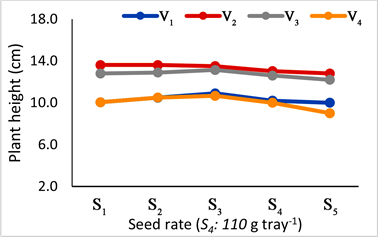 Note: Variety: V1: BRRI hybrid dhan3, V2: BRRI hybrid dhan5, V3: Ishpahani hybrid dhan6 and V4: BRRI dhan89 and Seed rate: S1: 80 g?tray?1, S2: 90 g?tray?1, S3: 100 g?tray?1, S4: 110 g?tray?1 and S5: 120 g?tray?1.
Note: Variety: V1: BRRI hybrid dhan3, V2: BRRI hybrid dhan5, V3: Ishpahani hybrid dhan6 and V4: BRRI dhan89 and Seed rate: S1: 80 g?tray?1, S2: 90 g?tray?1, S3: 100 g?tray?1, S4: 110 g?tray?1 and S5: 120 g?tray?1.
Figure 6. Seedling height after 14 days of sowing (S: p < 0.01, V: p < 0.01 and S × V: p > 0.05).
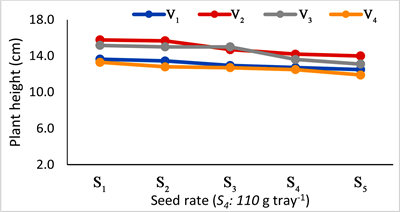 Note: Variety: V1: BRRI hybrid dhan3, V2: BRRI hybrid dhan5, V3: Ishpahani hybrid dhan6 and V4: BRRI dhan89 and Seed rate: S1: 80 g?tray?1, S2: 90 g?tray?1, S3: 100 g?tray?1, S4: 110 g?tray?1 and S5: 120 g?tray?1.
Note: Variety: V1: BRRI hybrid dhan3, V2: BRRI hybrid dhan5, V3: Ishpahani hybrid dhan6 and V4: BRRI dhan89 and Seed rate: S1: 80 g?tray?1, S2: 90 g?tray?1, S3: 100 g?tray?1, S4: 110 g?tray?1 and S5: 120 g?tray?1.
Figure 7. Seedling height after 21 days of sowing (S: p < 0.01, V: p < 0.01 and S × V: p > 0.05).
3.4. Number of Plants per Hill
Two-way interaction of varieties and seed rate did not show a significant effect on the number of plants per hill while only seed rate showed a significant effect on the number of plants per hill (Figure 9). There has no significant variation of plants per hill among the seed rate of 100, 110 and 120 g?tray?1 while lower number of plants per hill was observed for the seed rate of 80 and 90 g?tray?1. Most of countries, farmers plant 2 - 3 seedlings per hill [23]. For indicia rice, densities of 1.5 to 3 seedlings per 100 mm2 were required for minimizing the missing hills and maintaining the optimal number of seedlings per hill [24]. For mechanical transplanting, seedlings per hill should be maintained 2 - 4 to obtain optimum plant population [25] [26] because grain yield decreased with the increase of the number of seedlings hill?1 more than 4 seedlings [27] [28]. A seed rate of 120 g?tray?1 while plants per hill 4 - 5 in Boro season and 2 - 3 in Aman season was more satisfactory for mechanical transplanting of hybrid paddy [13].
 Note: Variety: V1: BRRI hybrid dhan3, V2: BRRI hybrid dhan5, V3: Ishpahani hybrid dhan6 and V4: BRRI dhan89 and Seed rate: S1: 80 g?tray?1, S2: 90 g?tray?1, S3: 100 g?tray?1, S4: 110 g?tray?1 and S5: 120 g?tray?1.
Note: Variety: V1: BRRI hybrid dhan3, V2: BRRI hybrid dhan5, V3: Ishpahani hybrid dhan6 and V4: BRRI dhan89 and Seed rate: S1: 80 g?tray?1, S2: 90 g?tray?1, S3: 100 g?tray?1, S4: 110 g?tray?1 and S5: 120 g?tray?1.
Figure 8. Number of hills per m2 (S: p < 0.01, V: p < 0.01 and S × V: p > 0.05).
 Note: Variety: V1: BRRI hybrid dhan3, V2: BRRI hybrid dhan5, V3: Ishpahani hybrid dhan6 and V4: BRRI dhan89 and Seed rate: S1: 80 g?tray?1, S2: 90 g?tray?1, S3: 100 g?tray?1, S4: 110 g?tray?1 and S5: 120 g?tray?1.
Note: Variety: V1: BRRI hybrid dhan3, V2: BRRI hybrid dhan5, V3: Ishpahani hybrid dhan6 and V4: BRRI dhan89 and Seed rate: S1: 80 g?tray?1, S2: 90 g?tray?1, S3: 100 g?tray?1, S4: 110 g?tray?1 and S5: 120 g?tray?1.
Figure 9. Number of plants per hill (S: p < 0.01, V: p > 0.05 and S × V: p > 0.05).
3.5. Percent of Missing Hills
Interaction of variety and seed rate did not affect significantly the percentage of missing hills while seed rate individually influenced the percentage of missing hills (Figure 10). Percentage of missing hills decreased significantly with the increase in seed rate irrespective of the varieties. Percentage of missing hills under the seed rate of 110 g?tray?1 was 1.3, 2.7, 2.6 and 1.2 for the BRRI hybrid dhan3, BRRI hybrid dhan5, Ishpahani hybrid dhan6 and BRRI dhan89 which it was 0.01, 1.4, 1.2 and 1.3 percent under the seed rate of 120 g?tray?1. But Basir et al., 2020 observed 6.3 percent of missing hills with a 5.46 of floating hills was observed in puddled soil whereas in unpuddled soil the parameters were 6.1 and 7.36 percent, respectively for the hybrid rice variety Moyna (HTM303) of Laal Teer Seed Company Ltd. under the seed rate of 120 g per tray [12]. On the other hand, Surajit et al., 2022 found missing hills 7.14%, 10.71%, and 3.57% in Boro and 13.4%, 7.693%, and 7.724%, in Aman season for the hybrid rice variety under the seed rate of 100, 110, and 120 while plants per hills 2 - 3, 2 - 4 and 4 - 5 in Boro season and 2 - 3, 3 - 4 and 4 - 5 for the Aman season under the same seed rate, respectively [13]. It might be varied with the seedling quality, seedlings per hill adjustment option in the rice transplanter, depth of planting etc.
3.6. Grain Yield (t?ha?1)
Two-way interaction of variety and seed rate per tray was found significant effect on yield. A significantly higher yield was observed for the variety of BRRI hybrid dhan5 under the seed rate of 110 g?tray?1 while it was statistically similar for the Ishpahani hybrid dhan6 under the same seed rate and BRRI hybrid dhan5 under the seed rate of 100 g?tray?1 (Figures 11-13).
 Note: Variety: V1: BRRI hybrid dhan3, V2: BRRI hybrid dhan5, V3: Ishpahani hybrid dhan6 and V4: BRRI dhan89 and Seed rate: S1: 80 g?tray?1, S2: 90 g?tray?1, S3: 100 g?tray?1, S4: 110 g?tray?1 and S5: 120 g?tray?1.
Note: Variety: V1: BRRI hybrid dhan3, V2: BRRI hybrid dhan5, V3: Ishpahani hybrid dhan6 and V4: BRRI dhan89 and Seed rate: S1: 80 g?tray?1, S2: 90 g?tray?1, S3: 100 g?tray?1, S4: 110 g?tray?1 and S5: 120 g?tray?1.
Figure 10. Percent of missing hills as affected by variety and seed rate where (S: p < 0.01, V: p > 0.05 and S × V: p > 0.05).
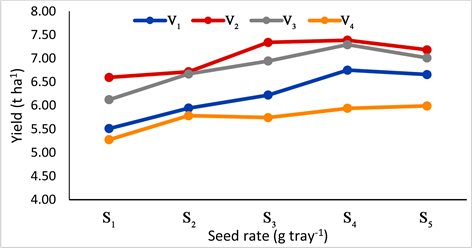 Note: Variety: V1: BRRI hybrid dhan3, V2: BRRI hybrid dhan5, V3: Ishpahani hybrid dhan6 and V4: BRRI dhan89 and Seed rate: S1: 80 g/tray, S2: 90 g/tray, S3: 100 g/tray and S4: 110 g/tray.
Note: Variety: V1: BRRI hybrid dhan3, V2: BRRI hybrid dhan5, V3: Ishpahani hybrid dhan6 and V4: BRRI dhan89 and Seed rate: S1: 80 g/tray, S2: 90 g/tray, S3: 100 g/tray and S4: 110 g/tray.
Figure 11. Effect of variety and seed rate on yield (t/ha) where S × V: p < 0.01.
 Note: Variety: V1: BRRI hybrid dhan3, V2: BRRI hybrid dhan5, V3: Ishpahani hybrid dhan6 and V4: BRRI dhan89 and Seed rate: S1: 80 g/tray, S2: 90 g/tray, S3: 100 g/tray and S4: 110 g/tray.
Note: Variety: V1: BRRI hybrid dhan3, V2: BRRI hybrid dhan5, V3: Ishpahani hybrid dhan6 and V4: BRRI dhan89 and Seed rate: S1: 80 g/tray, S2: 90 g/tray, S3: 100 g/tray and S4: 110 g/tray.
Figure 12. Effect of seed rate on yield where S: p < 0.01.
 Note: Variety: V1: BRRI hybrid dhan3, V2: BRRI hybrid dhan5, V3: Ishpahani hybrid dhan6 and V4: BRRI dhan89 and Seed rate: S1: 80 g/tray, S2: 90 g/tray, S3: 100 g/tray and S4: 110 g/tray.
Note: Variety: V1: BRRI hybrid dhan3, V2: BRRI hybrid dhan5, V3: Ishpahani hybrid dhan6 and V4: BRRI dhan89 and Seed rate: S1: 80 g/tray, S2: 90 g/tray, S3: 100 g/tray and S4: 110 g/tray.
Figure 13. Effect of variety on yield where p < 0.01.
3.7. Thousand Grain Weight (g)
Two-way interaction of variety and seed did not show a significant effect on 1000 grain weight while variety and seed rate individually showed a significant effect on 1000 grain weight (Figures 14-16). A significantly higher 1000 grain weight was observed for the variety of BRRI hybrid dhan5 under the seed rate of 110 g/tray while it was similar under the seed rate of 120, 100, and 90 g?tray?1. Among the four varieties, 1000 grain weight was more for BRRI hybrid dhan5 followed by BRRI hybrid dhan3 and Ishpahani hybrid dhan6 while lower 1000
![]()
Figure 14. Effect of variety and seed rate on 1000 grain weight (g) where S × V: p > 0.05.
![]()
Figure 15. Effect of seed rate on 1000 grain weight (g) where S: p < 0.01.
![]()
Figure 16. Effect of variety on 1000 grain weight (g) where p < 0.01.
grain weight was observed for BRRI dhan89 (Figure 16). Significant effect was also observed for seed rate on 1000 grain weight. Higher 1000 grain weight was counted for the seed rate of 110 g/tray while it was similar for 120 g?tray?1. Lower 1000 grain weight was observed for 80, 90, and 100 g?tray?1 (Figure 15). It could the causes of minimum missing hills and uniform plant population under the seed rate of 110 and 120 g?tray?1 while 80 - 100 g/tray gave higher missing hills which affected uniform plant population and plant parameters. Seed density varied considerably with the same seed rate for different types of varieties. The seed rate and the 1000 grain weight vary from one variety to another [29]. 27.75 g 1000 grain weight of BR3 and 19.64 g 1000 grain weight of BRRI dhan50 was found the same seed rate [9].
3.8. Hills per m2
The two-way interaction of variety and seed rate showed a significant effect on hills per meter square as were the single effect of variety and seed rate (Figures 17-19). A significantly higher number of hills per unit area were observed at 100 to 110 g?tray?1 seed rate irrespective of the varieties while seed rate of 120 was identical. Among the four varieties, hills per unit area were observed for BRRI hybrid dhan5 and Ishpahani hybrid dhan6. Higher hills per unit area were also counted for the seed rate of 110 g?tray?1 while it was similar for 100 g?tray?1. The
![]()
Figure 17. Effect of variety and seed rate on hills per m2 where S × V: p < 0.05.
![]()
Figure 18. Effect of seed rate on hills per m2 where S: p < 0.01.
![]()
Figure 19. Effect of variety on hills per m2 where p < 0.01.
hills per square meter depends on seed rate. The seedlings per hill increased with increasing seed rates. Seedling per unit area was observed considerably similar to the seed rate of 130 - 160 g?tray?1 of BR3 grain (2.0 to 2.2 numbers per square cm) and BRRI dhan28 (2.3 to 2.6 numbers per square cm) [9]. However, the seedling per hill influences both tillers and panicles and also the number of panicles is positively related with yield. The panicles/m2 and seeding per hill ought to be emphasized in hybrid rice production [30].
4. Conclusion
Currently, hybrid rice is being mechanically transplanted in Bangladesh. The identification of optimum seed rate is essential for mat type seedling raising in order to increase crop yield while maintaining the seed rate of high value hybrid seed. Slender type grains of hybrid rice varieties, 100 to 110 g?tray?1 seeds may be recommended for mat type seedling raising of hybrid rice, taking into account the hill density, seedling height, mat-quality, number of hills per unit area, number of plants per hill, missing hills, as well as grain production.
Acknowledgements
The authors acknowledge all scientists and staff of Farm Machinery and Post-harvest Technology Division, BRRI for providing support to conduct the experiment.
Funding Statement
This study was conducted under the funding support of KGF-BKGET project entitle “Validation and up-scaling of rice transplanting and harvesting technology in the selected sites of Bangladesh (VRTHB project-ID No. TF 89-AM/21)”, Bangladesh Rice Research Institute, Gazipur.
Authors’ Contribution
MA Hossen generated the idea, design the experiment and developed the methodology; M Kamruzzaman coordinated the activities, MM Shahriyar and AU Khan laid out the experiment and data collection from time to time according to the design; S Islam and H Paul helped in data analysis and draft report preparation; all authors read and approved the final manuscript.
Availability of Data and Material
Data used in this study are available from the first author upon request (dranwarhossenbrri@gmail.com).